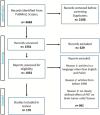Photodynamic therapy and associated targeting methods for treatment of brain cancer
- PMID: 37841921
- PMCID: PMC10568033
- DOI: 10.3389/fphar.2023.1250699
Photodynamic therapy and associated targeting methods for treatment of brain cancer
Abstract
Brain tumors, including glioblastoma multiforme, are currently a cause of suffering and death of tens of thousands of people worldwide. Despite advances in clinical treatment, the average patient survival time from the moment of diagnosis of glioblastoma multiforme and application of standard treatment methods such as surgical resection, radio- and chemotherapy, is less than 4 years. The continuing development of new therapeutic methods for targeting and treating brain tumors may extend life and provide greater comfort to patients. One such developing therapeutic method is photodynamic therapy. Photodynamic therapy is a progressive method of therapy used in dermatology, dentistry, ophthalmology, and has found use as an antimicrobial agent. It has also found wide application in photodiagnosis. Photodynamic therapy requires the presence of three necessary components: a clinically approved photosensitizer, oxygen and light. This paper is a review of selected literature from Pubmed and Scopus scientific databases in the field of photodynamic therapy in brain tumors with an emphasis on glioblastoma treatment.
Keywords: PDT; brain cancer; diagnostics; glioblastoma; treatment.
Copyright © 2023 Bartusik-Aebisher, Serafin, Dynarowicz and Aebisher.
Conflict of interest statement
The authors declare that the research was conducted in the absence of any commercial or financial relationships that could be construed as a potential conflict of interest.
Figures






Similar articles
-
The Use of Photodynamic Therapy in the Treatment of Brain Tumors-A Review of the Literature.Molecules. 2022 Oct 13;27(20):6847. doi: 10.3390/molecules27206847. Molecules. 2022. PMID: 36296440 Free PMC article. Review.
-
Photodynamic Therapy for the Treatment of Glioblastoma.Front Surg. 2020 Jan 21;6:81. doi: 10.3389/fsurg.2019.00081. eCollection 2019. Front Surg. 2020. PMID: 32039232 Free PMC article. Review.
-
Nanomedicine associated with photodynamic therapy for glioblastoma treatment.Biophys Rev. 2017 Oct;9(5):761-773. doi: 10.1007/s12551-017-0293-3. Epub 2017 Aug 19. Biophys Rev. 2017. PMID: 28823025 Free PMC article. Review.
-
Photosensitizers for Photodynamic Therapy of Brain Cancers-A Review.Brain Sci. 2023 Sep 8;13(9):1299. doi: 10.3390/brainsci13091299. Brain Sci. 2023. PMID: 37759900 Free PMC article. Review.
-
Nanomedicine in Clinical Photodynamic Therapy for the Treatment of Brain Tumors.Biomedicines. 2022 Jan 3;10(1):96. doi: 10.3390/biomedicines10010096. Biomedicines. 2022. PMID: 35052776 Free PMC article. Review.
Cited by
-
Photodynamic Therapy for Eye, Ear, Laryngeal Area, and Nasal and Oral Cavity Diseases: A Review.Cancers (Basel). 2024 Feb 2;16(3):645. doi: 10.3390/cancers16030645. Cancers (Basel). 2024. PMID: 38339396 Free PMC article. Review.
-
Photodynamic Therapy and Immunological View in Gastrointestinal Tumors.Cancers (Basel). 2023 Dec 22;16(1):66. doi: 10.3390/cancers16010066. Cancers (Basel). 2023. PMID: 38201494 Free PMC article. Review.
-
Photodynamic opening of the blood-brain barrier affects meningeal lymphatics and the brain's drainage in healthy male mice.Biomed Opt Express. 2024 Sep 26;15(10):6063-6072. doi: 10.1364/BOE.527892. eCollection 2024 Oct 1. Biomed Opt Express. 2024. PMID: 39421760 Free PMC article.
-
What is the Reason That the Pharmacological Future of Chemotherapeutics in the Treatment of Lung Cancer Could Be Most Closely Related to Nanostructures? Platinum Drugs in Therapy of Non-Small and Small Cell Lung Cancer and Their Unexpected, Possible Interactions. The Review.Int J Nanomedicine. 2024 Sep 14;19:9503-9547. doi: 10.2147/IJN.S469217. eCollection 2024. Int J Nanomedicine. 2024. PMID: 39296940 Free PMC article. Review.
-
Photo-controlled co-delivery of verteporfin and acriflavine via platelets achieves potentiated glioblastoma-targeted photodynamic therapy.J Nanobiotechnology. 2025 May 22;23(1):371. doi: 10.1186/s12951-025-03395-x. J Nanobiotechnology. 2025. PMID: 40405165 Free PMC article.
References
-
- Awad A. J., Sloan A. (2014). The use of 5-ALA in glioblastoma resection: Two cases with long-term progression-free survival. Cureus 6, e202. 10.7759/cureus.202 - DOI
Publication types
LinkOut - more resources
Full Text Sources

